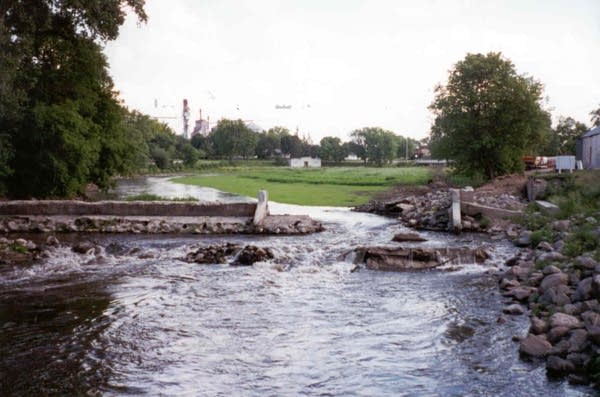DNR removing old dams at slow pace
Go Deeper.
Create an account or log in to save stories.
Like this?
Thanks for liking this story! We have added it to a list of your favorite stories.

Back in the early 1900s, Minnesotans built a lot of dams -- to run sawmills, make electricity, create lakes and try to control flooding.
As a result, Minnesota's rivers and streams have a lot of small dams on them. At last count, there were 1,300 -- many of them aging, unsafe and unnecessary.
Officials with the state Department of Natural Resources are using a 25-year-old state program to remove old dams and restore the natural flows of rivers, a process that can lead to increased numbers of fish.
That's what happened on the Kettle River, just south of Sandstone, where water forms foaming waves as it collides with boulders in a narrow stretch bounded by rock walls.
Turn Up Your Support
MPR News helps you turn down the noise and build shared understanding. Turn up your support for this public resource and keep trusted journalism accessible to all.
A dam was built there to make electricity, but by 1995 it wasn't producing power anymore, and it was torn down. It would have cost twice as much to repair it as to demolish it. And it was dangerous.
"It was a safety issue. People had lost lives," said Dean Paron, a fisheries expert for the DNR. "It was an attractive nuisance."
Paron, who used to fish there with his grandfather, has learned how special the Kettle River is.

For one thing, it contains sturgeon -- the ancient fish that can grow up to 60 inches long and weigh 90 pounds. There was one group of sturgeon living above the dam, and one group below it. Not only were they separated from each other, Paron said, but the dam probably interfered with their ability to spawn.
"One of the things with sturgeon is that certain flows trigger them to spawn," he said. "When you have a river with a dam on it, it may be mitigating these flows that trigger the sturgeon to spawn."
Now that the dam has been removed, the sturgeon receive the right signal from the river. They also have a much bigger home.
Other species that have benefited from the dam removal include smallmouth and largemouth bass, catfish, northern pike and walleye. Even the occasional muskie patrols area waters.
The Kettle River also is rich in mussels, which depend on the fish hosts that their larvae, called glochidia, attach to.

"A lot of them are host-specific. They rely on one particular species of fish," Paron said. "If that fish disappears because it can no longer get upstream because of a dam, that mussel will also disappear."
Because mussels filter the water, Paron said a good population of mussels is a sign of a healthy ecosystem.
Even the land next to the river is healthier now. Otters, beavers, turtles, deer -- all thrive on a natural riverbank.
The Kettle is a great canoeing and kayaking river, with several exciting rapids -- one of them where the dam was.
Minnesota has 1,300 small dams. DNR officials have identified about 100 that should be repaired, torn down or modified to improve fish habitat. The agency is in a race against time. It expects more dam failures like one in Oronoco that occurred earlier this fall.
But the DNR only receives up to $2 million each year to work on dams. Since the program began, only 17 have been removed, and 25 have been modified to improve safety and wildlife habitat.

Luther Aadland, a river ecologist for the DNR, said if the agency took full advantage of the benefits of dam removal, the state could save money on its fish restocking program.
"We build dams on these tributaries that block off critical spawning habitat for fish like walleyes, that we spend lots of money to stock," Aadland said. "If we connected and restored some of those historic spawning habitats, we wouldn't have to be spending so much money on something we have to do every year."
The DNR's budget for addressing dams is much smaller than its budget for stocking fish, which is roughly $7 million a year.
As for flood prevention, Aadland said dams only represent a short-term solution. A reservoir will typically fill up with silt in the course of the 50- to 60-year life of its dam, and then there's no room left to store water. If the dam fails, the flooding is worse.
But it can be expensive and time-consuming to overcome resistance to dam removal. Neighbors love their ponds, and people with docks usually don't want the water level to go down.
In Appleton, for example, residents loved the mill pond in Riverview Park. As the dam deteriorated, they debated for years about what to do. City Clerk-Treasurer Roman Fidler said a flood in 1997 broke the dam and forced the city to make a decision. The DNR paid to have the dam removed, and to build a more natural rock rapids.
"My understanding, talking with people in town, is the fishing improved immensely once the dam was gone because fish could get upriver a lot farther," Fidler said. "I would say now that people are really happy with what's there."
Next year, the DNR plans to modify two dams on the Red River south of Moorhead to allow the fish to swim upstream, and to remove a dam on the Rock River in Luverne.
Also under study are dams in Granite Falls and Montevideo, and the one in Oronoco.




